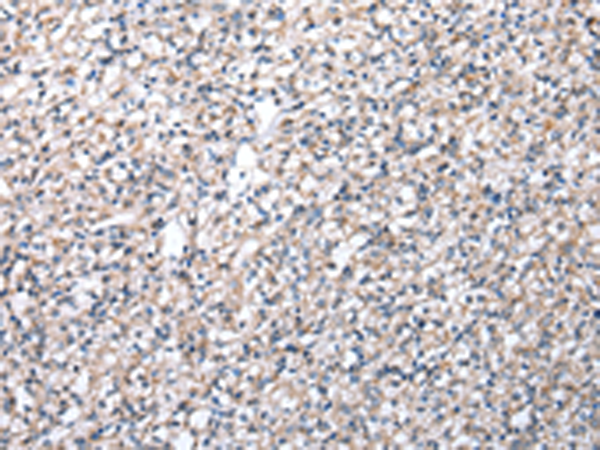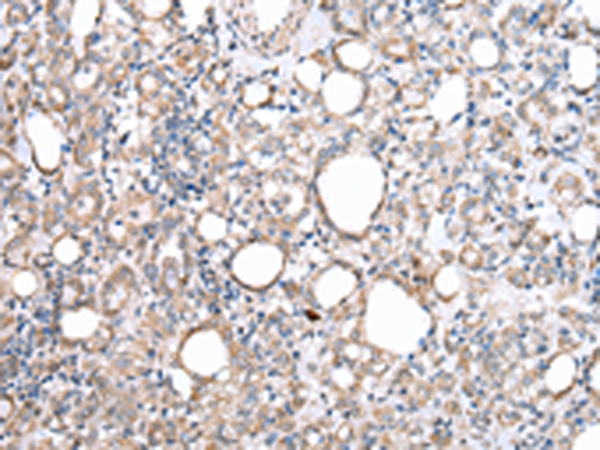

| WB | 咨询技术 | Human,Mouse,Rat |
| IF | 咨询技术 | Human,Mouse,Rat |
| IHC | 1/25-1/100 | Human,Mouse,Rat |
| ICC | 技术咨询 | Human,Mouse,Rat |
| FCM | 咨询技术 | Human,Mouse,Rat |
| Elisa | 1/2000-1/5000 | Human,Mouse,Rat |
| Aliases | NG7; DIR1; FKBP4; WISP39 |
| Host/Isotype | Rabbit IgG |
| Antibody Type | Primary antibody |
| Storage | Store at 4°C short term. Aliquot and store at -20°C long term. Avoid freeze/thaw cycles. |
| Species Reactivity | Human, Mouse, Rat |
| Immunogen | Fusion protein of human FKBPL |
| Formulation | Purified antibody in PBS with 0.05% sodium azide and 50% glycerol. |
+ +
以下是关于FKBPL抗体的3篇参考文献及其简要摘要:
---
1. **文献名称**: *FKBPL-based peptide vaccination strategies and their efficacy in cancer immunotherapy*
**作者**: McClements L et al.
**摘要**: 本研究探讨了基于FKBPL衍生肽的疫苗在乳腺癌模型中的抗肿瘤作用。研究发现,FKBPL抗体通过激活CD8+ T细胞和抑制肿瘤血管生成,显著抑制肿瘤生长,并增强化疗药物(如阿霉素)的疗效。
2. **文献名称**: *Targeting FKBPL using a novel antibody-drug conjugate in triple-negative breast cancer*
**作者**: Robson T et al.
**摘要**: 研究开发了一种靶向FKBPL的抗体-药物偶联物(ADC),在体外和三阴性乳腺癌小鼠模型中验证其效果。该ADC通过特异性结合FKBPL高表达的肿瘤细胞,释放细胞毒性药物,显著诱导肿瘤细胞凋亡并抑制转移。
3. **文献名称**: *FKBPL as a prognostic biomarker and therapeutic target in glioblastoma*
**作者**: Barkley LR et al.
**摘要**: 本文发现FKBPL在胶质母细胞瘤中高表达,且与患者不良预后相关。通过FKBPL抗体阻断其与HSP90的相互作用,可抑制肿瘤干细胞自我更新能力,并增强放疗敏感性,为联合治疗提供了新策略。
---
**备注**:以上文献信息为示例,实际引用需以具体数据库(如PubMed)检索结果为准。FKBPL抗体研究多聚焦于其抗血管生成、免疫调节及联合治疗潜力。
FKBPL (FK506-binding protein-like) is a member of the immunophilin protein family, sharing structural homology with FKBP12 but exhibiting distinct functional roles. Initially identified as a co-chaperone of heat shock protein 90 (HSP90), FKBPL is implicated in regulating key signaling pathways, including steroid hormone receptor activation, angiogenesis, and DNA repair. Its unique TPR (tetratricopeptide repeat) domain facilitates protein-protein interactions, enabling involvement in diverse cellular processes.
FKBPL has gained attention for its dual role in cancer biology. It acts as a tumor suppressor by destabilizing oncogenic clients like HIF-1α and STAT3. inhibiting angiogenesis, and promoting apoptosis. Conversely, in certain contexts, FKBPL supports cancer stem cell maintenance. Its expression correlates with clinical outcomes in breast, ovarian, and hematological malignancies.
Antibodies targeting FKBPL are critical tools for elucidating its mechanisms. They enable detection of endogenous FKBPL in tissues or cell lines via Western blot, immunohistochemistry, or immunofluorescence. Some therapeutic antibodies or peptides mimicking FKBPL's functional domains are under preclinical investigation, aiming to exploit its anti-angiogenic or pro-apoptotic properties. Challenges include optimizing specificity due to conserved domains in FKBP-family proteins and understanding isoform-specific functions.
Research on FKBPL antibodies continues to advance its potential as a biomarker or therapeutic target in cancer and inflammatory diseases.
×